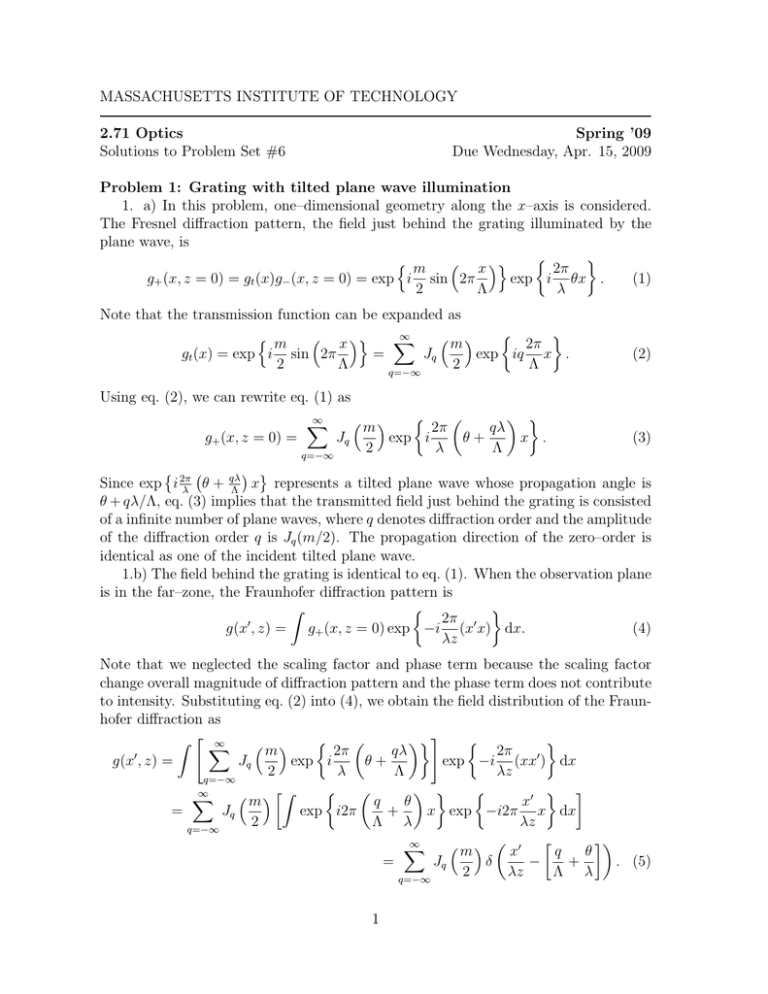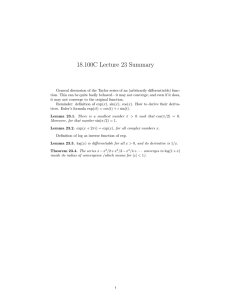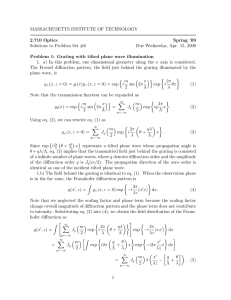Document 13612077
advertisement

MASSACHUSETTS INSTITUTE OF TECHNOLOGY 2.71 Optics Solutions to Problem Set #6 Spring ’09 Due Wednesday, Apr. 15, 2009 Problem 1: Grating with tilted plane wave illumination 1. a) In this problem, one–dimensional geometry along the x–axis is considered. The Fresnel diffraction pattern, the field just behind the grating illuminated by the plane wave, is � � � m � x �� 2π exp i θx . (1) g+ (x, z = 0) = gt (x)g− (x, z = 0) = exp i sin 2π 2 Λ λ Note that the transmission function can be expanded as � � ∞ � m �m� � x �� � 2π Jq = exp iq x . gt (x) = exp i sin 2π 2 Λ 2 Λ q=−∞ (2) Using eq. (2), we can rewrite eq. (1) as g+ (x, z = 0) = ∞ � q=−∞ Jq �m� 2 � � � � 2π qλ exp i θ+ x . λ Λ (3) � � � � Since exp i 2λπ θ + qλ x represents a tilted plane wave whose propagation angle is Λ θ + qλ/Λ, eq. (3) implies that the transmitted field just behind the grating is consisted of a infinite number of plane waves, where q denotes diffraction order and the amplitude of the diffraction order q is Jq (m/2). The propagation direction of the zero–order is identical as one of the incident tilted plane wave. 1.b) The field behind the grating is identical to eq. (1). When the observation plane is in the far–zone, the Fraunhofer diffraction pattern is � � � 2π (4) g(x , z) = g+ (x, z = 0) exp −i (x x) dx. λz Note that we neglected the scaling factor and phase term because the scaling factor change overall magnitude of diffraction pattern and the phase term does not contribute to intensity. Substituting eq. (2) into (4), we obtain the field distribution of the Fraun­ hofer diffraction as � � ��� � � � �� ∞ �m� 2π qλ 2π Jq exp i θ+ exp −i (xx ) dx g(x , z) = 2 λ Λ λz q=−∞ � � � � � � � ∞ � m � �� � q θ x Jq exp i2π + x exp −i2π x dx = 2 Λ λ λz q=−∞ � �� ∞ � m � � x � q θ = Jq δ − + . (5) 2 λz Λ λ q=−∞ 1 (a) on–axis plane wave (b) tilted plane wave Figure 1: The whole diffraction patterns rotate by θ as the incident plane wave rotates The intensity of the Fraunhofer diffraction pattern is 2 I(x , z) = |g(x , z)| = ∞ � Jq2 q=−∞ � �� � m � � x q θ δ − + . 2 λz Λ λ (6) In the far–region, we should observe a infinite number of diffraction orders. The in­ tensity of the diffraction order is proportional to Jq2 (m/2) and the offset between two neighboring diffraction orders is (λz)/Λ. The zeroth order is located at x = zθ. 1.c) In both cases (Fresnel and Fraunhofer diffraction), the diffraction patterns of the grating probed by a on-axis and tilted plane waves are identical except the angular shift by the incident angle θ, as shown in Fig. 1. 2 Problem 2: Grating spherical wave illumination 2.a) Using the same approach as in Prob. 1, we obtain � � � x �� ei2π zλ0 1� x2 + y 2 g+ (x, y, z = 0) = gt (x, y)g− (x, y, z = 0) = 1 + m cos 2π exp iπ . 2 Λ iλz0 λz0 (7) 2.b) Since both the cosine term and exponential terms in eq. (8) vary with x, we use following relation to understand eq. (8); � � � x� m� x� x �� =1+ exp i2π + exp −i2π . (8) 1 + m cos 2π Λ 2 Λ Λ Hence, eq. (8) can be rewritten as superposition of three spherical waves; � � � z0 e i2π λ 1 x2 + y 2 g+ (x, y, z = 0) = exp iπ + iλz0 2 λz0 � � � �� x x x2 + y 2 m x2 + y 2 m + exp iπ − i2π exp iπ + i2π 4 λz0 Λ 4 λz0 Λ � � � � � � � z0 e i2π λ 1 x2 + y 2 (x + λz0 /Λ)2 + y 2 m λz0 = exp iπ + exp iπ exp −iπ 2 + iλz0 2 λz0 4 λz0 Λ � � � �� 2 2 m (x − λz0 /Λ) + y λz0 exp iπ exp −iπ 2 . (9) 4 λz0 Λ 2.c) Figure 2(a) conceptually shows the diffraction pattern expressed in eq. (10). The first exponential term represents the zero–order diffraction, which is identical to the incident spherical wave originated at (x = 0, y = 0, z = −z0 ) except amplitude attenuation. The second and third exponential terms indicate two spherical waves 2 originated at (±λz0 /Λ, 0, −z0 ) with additional phase factor of e−iπλz0 /Λ , which is in­ dependent on x and y. 2.d) If the illumination is a spherical wave emitted at (x0 , 0, −z0 ) as shown in Fig. 2(b), then we expect that the origins of the three spherical waves will be shifted by x0 ; i.e., the three origins are (x0 , 0, −z0 ), (x0 − λz0 /Λ, 0, −z0 ), and (x0 + λz0 /Λ, 0, −z0 ) if the paraxial approximation holds. More rigorously, the Fresnel diffraction pattern is computed as � � � x �� ei2π zλ0 1� (x − x0 )2 + y 2 1 + m cos 2π g+ (x, z = 0) = exp iπ , (10) 2 Λ iλz0 λz0 3 (a) on–axis spherical wave (b) off–axis spherical wave Figure 2: The diffraction patterns rotate in the same fashion as the incident spherical wave rotates and using the same expansion we eventually obtain � � � z0 ei2π λ 1 (x − x0 )2 + y 2 exp iπ + g+ (x, y, z = 0) = iλz0 2 λz0 � � � �� m (x − x0 )2 + y 2 x m (x − x0 )2 + y 2 x + exp iπ − i2π exp iπ + i2π 4 λz0 Λ 4 λz0 Λ � � � z0 ei2π λ 1 (x − x0 )2 + y 2 = exp iπ + iλz0 2 λz0 � � � � �� (x − x0 + λz0 /Λ)2 + y 2 2x0 λz0 m exp iπ exp −iπ − + 2 + 4 λz0 Λ Λ � � � � �� � 2 2 (x − x0 − λz0 /Λ) + y 2x0 λz0 m exp iπ exp −iπ + 2 . (11) 4 λz0 Λ Λ As expected, the diffraction pattern is consisted of three spherical waves originated at (x0 , 0, −z0 ), (x0 − λz0 /Λ, 0, −z0 ), and (x0 + λz0 /Λ, 0, −z0 ), respectively. 4 3. (a) The Fourier series coefficients of a periodic function t(x) are given by: � L 2 1 t(x� )dx� a0 = L − L2 � � � L 2 2 nπx� � an = t(x ) cos dx� L L −2 L/2 � � � L 2 nπx� � bn = t(x ) sin dx� L −L L/2 where L is the period of t(x). The function t(x) can then be written as an infinite sum: � � � � � ∞ ∞ � nπx nπx t(x) = a0 + an cos + bn sin L/2 L/2 n=1 n=1 For the given function, � L 1 4 1 a0 = dx� = L − L4 2 � � � �� L � L � πn � 2 4 2πnx� 2� L 2πnx� �� 4 2 � � an = cos dx = · sin � L = πn sin 2 L − L4 L L L � 2 � πn −4 � � � � �� L � � L � � 4 2 4 2πnx� 2 L 2πnx � � � bn = sin − cos = 0 dx� = · L − L4 L L L � − L � 2 � πn 4 � � �� 0 � � sin πn 1 2 ∴ a0 = , bn = 0, an = where n = 1, 2, 3, . . . πn 2 2 Note that when n is even, an = 0, when n = 1 + 4m, an = +1, and when n = 3 + 4m, an = −1, where m is a positive integer. (b) A single boxcar is given by � t1 (x) = rect 2x L � L T1 (u) = F(t1 (x)) = sinc 2 5 � L u 2 � (c) An infinite array of boxcars of width L2 with a spacing of L2 between them can be expressed as a convolution of a comb() function and a rect() function: � � �x� 2x t2 (x) = rect ⊗ comb L L A truncated centered portion containing N boxcars is then given by � � � x � � � x �� � x � 2x t(x) = t2 (x) · rect = rect ⊗ comb · rect NL L L NL The Fourier transform of t(x) becomes � 2 � � � L L T (u) = T2 (u) ⊗ (NL)sinc(NLu) = sinc u · comb(Lu) ⊗ (NL)sinc(NLu) 2 2 (d) Single box car: T (u) = L2 sinc( L2 u) Infinite array: 6 Finite array (N): • The Fraunhofer diffraction pattern is similar to the Fourier transform of the functions (with a scaling factor u = x/λL) • A single box car creates a sinc() diffraction pattern. Having an infinitely long array would generate a set of δ() functions, i.e. single dots whose amplitude is modulated by a sinc() envelope profile identical to that generated by one boxcar. The spacing of the δ()’s is the reciprocal of the period of the array. • A finite array of boxcars generates a set of sinc() functions whose peaks are modulated by another sinc() function and whose spacing is the reciprocal of the period of the boxcar array. Limiting the size of the array is equivalent to imposing a window onto an infinite array. This window spreads the δ() functions into sinc() functions. The spread of each of these sinc()’s is inversely proportional to the width of the ‘window.’ 4. Tilted ellipse: �� � x2 + y 2 Circle: f2 (x2 , y2 ) = circ r a b Ellipse: x1 = x2 ; y1 = y2 r r r r x 2 = x 1 ; y2 = y 1 a b Tilted: x = x1 cos θ − y1 sin θ y = x1 sin θ + y1 cos θ �� � �� � � x �2 � y �2 ( ar x1 )2 + ( rb y1 )2 1 1 f1 (x1 , y2 ) = circ = circ + r a b 7 F1 (u1 , v1 ) = F(f1 ) = |ab|jinc(2π � (au1 )2 + (bv1 )2 ) A rotation by θ in the space domain is equivalent to a rotation by θ in the frequency domain; hence, u1 = u cos θ + v sin θ, v1 = −u sin θ + v cos θ ∴ The Fourier transform of an ellipse tilted by an angle θ is � F (u, v) = |ab|jinc(2π a2 (u cos θ + v sin θ)2 + b2 (−u sin θ + v cos θ)2 ) (a) Sketch of Fourier transform (b) The Fraunhofer diffraction pattern is given by � � � � � � � � � x x y y = | ab| jinc 2π a 2 ( cos θ + sin θ)2 + b2 (− sin θ + cos θ)2 F (u, v) �� λ� λ� λ� λ� x� y � ( , ) λ� λ� 8 MIT OpenCourseWare http://ocw.mit.edu 2.71 / 2.710 Optics Spring 2009 For information about citing these materials or our Terms of Use, visit: http://ocw.mit.edu/terms.






